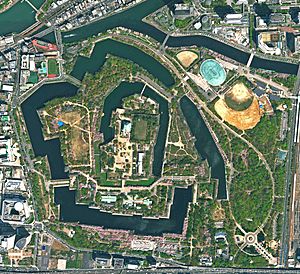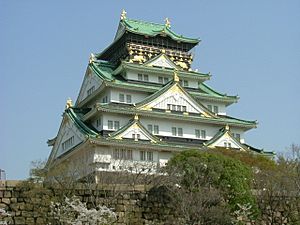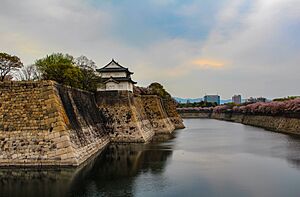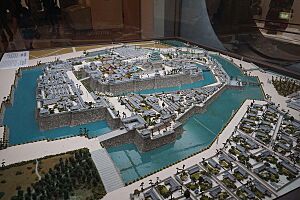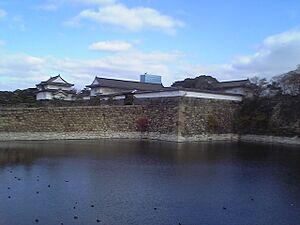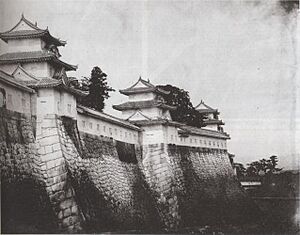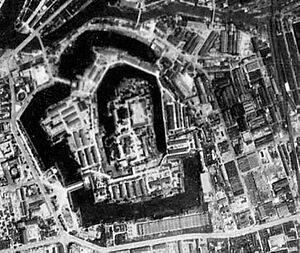Osaka Castle facts for kids
Quick facts for kids Osaka Castle大坂城 |
|
|---|---|
| Osaka, Japan | |

|
|
| Type | Azuchi-Momoyama castle |
| Site information | |
| Condition | Reconstructed |
| Site history | |
| Built | 1583 |
| Built by | Toyotomi Hideyoshi |
| In use | 1583–1945 |
Osaka Castle (大坂城 or 大阪城, Ōsaka-jō) is a famous Japanese castle located in Chūō-ku, Osaka, Japan. It is one of Japan's most well-known landmarks. This amazing castle played a very important part in bringing Japan together during the 1500s. This time was known as the Azuchi–Momoyama period.
Osaka Castle: A Historic Japanese Landmark
What Does Osaka Castle Look Like?
Osaka Castle is built on a large piece of land, about one square kilometer. It stands on two high platforms made of earth and supported by strong stone walls. These walls were built using a special method called "burdock piling." The main castle building, called the keep, looks like it has five floors from the outside. Inside, it actually has eight floors! It sits on a tall stone base to keep everyone inside safe from attackers.
Castle Defenses: Moats and Walls
The castle is protected by two main moats: an inner moat and an outer moat. The inner moat is inside the castle grounds. Parts of it are filled with water, and other parts are dry. The outer moat goes all the way around the entire castle area. It marks the very edge of the castle and is made up of four sections, each filled with water.
The castle grounds are huge, covering about 61,000 square meters (about 15 acres). Many parts of the castle are considered "important cultural assets" by the Japanese government. These include gates like the Ote-mon Gate and Sakura-mon Gate, and several defense towers called turrets. There are also important structures like the Kinmeisui Well, the Kinzo Storehouse, and the Enshogura Gunpowder Magazine.
You can also see some very large stones, called megaliths, at the castle. One famous one is the Octopus stone. To get into the outer moat area, there are two main checkpoints: the Aoyamon Gate and the Otemon Gate.
Inside the Castle Walls
Between the inner and outer moats, you'll find other interesting places. These include the Osaka Castle Nishinomaru Garden, the Osaka State Guest House, and the Hokoku Shrine. To cross the inner moat, there are two bridges: Gokuraku-bashi Bridge and Sakuramon Gate.
Inside the inner moat, the castle was divided into two main sections: the Hommaru (Inner Bailey) and the Yamazato-Maru Bailey. The Hommaru holds the Main Tower, the Kimmeisui Well, and the Kinzo Treasure House. The Yamazato-Maru Bailey has the Marked-Stones Square and a monument remembering important historical figures.
The main tower, known as the tenshu, was used as a storage place during peaceful times. During wars, it became a strong defense tower. The castle also had offices and homes for the feudal lord (called a daimyo) and his staff. These were usually in smaller buildings near the tenshu and the surrounding defense towers (yagura).
The Story of Osaka Castle
Building a Dream: Toyotomi Hideyoshi's Castle
Construction of Osaka Castle began in 1583. It was started by a powerful leader named Toyotomi Hideyoshi. He wanted to build a castle that was even grander than others he had seen. His plan included a five-story main tower, with three more floors hidden underground. He even used gold leaf on the sides of the tower to make it look extra impressive!
By 1585, the inner part of the castle was finished. Hideyoshi kept adding to the castle, making it stronger and more difficult for enemies to attack. The entire castle was completed in 1597. Hideyoshi passed away the next year, and his son, Toyotomi Hideyori, took over the castle.
The Great Sieges and Rebuilding
In 1614, another powerful leader, Tokugawa Ieyasu, attacked Osaka Castle. This was known as the Siege of Osaka. Even though Hideyori's forces were outnumbered, they bravely defended the castle's outer walls. Ieyasu then had the castle's outer moat filled in, which removed one of its main defenses.
In the summer of 1615, Hideyori tried to rebuild the outer moat. Ieyasu was very angry and sent his armies to attack Osaka Castle again. This time, the castle fell to the Tokugawa shogunate, and the castle buildings were burned down.
After this, the Tokugawa shogunate decided to rebuild Osaka Castle. In 1620, the old castle structures were completely taken apart. New, strong walls were built using huge granite boulders fitted together without any mortar. Many of these stones still have the crests of the samurai families who helped build them. The shogunate also built a new, taller main tower, which was finished around 1628.
However, the castle faced more challenges. In 1660, a lightning strike caused a gunpowder warehouse to explode, leading to a fire. Then, in 1665, lightning struck the main tower itself, burning it down.
There's a famous legend about a samurai guard named Kajisuke Nakama. In 1740, he supposedly stole gold from the castle. He was caught and punished. Later, the story changed, saying he was a thief looking for gold that Toyotomi Hideyoshi had hidden in a well.
In 1843, after many years of not being cared for, the castle received much-needed repairs. Money was collected from people in the area to fix several of the defense towers.
Modern Times: From Arsenal to Museum
In 1868, during a time of big changes in Japan called the Meiji Restoration, Osaka Castle was taken over by forces loyal to the emperor. Many castle buildings were burned during these conflicts.
Under the new Meiji government, Osaka Castle became part of the Osaka Army Arsenal. This was a factory that made guns, ammunition, and explosives for Japan's growing military.
In 1931, a new main tower was built using ferroconcrete (reinforced concrete).
During World War II, the arsenal became a huge military factory, employing 60,000 workers. American bombing raids aimed at the arsenal damaged the main tower. On August 14, 1945, 90% of the arsenal was destroyed, and many people working there lost their lives.
In 1995, the government of Osaka decided to restore the main tower again. They wanted to make it look like it did during the Edo period. The restoration was finished in 1997. Today, the main tower is a modern museum inside, complete with elevators, allowing visitors to learn about the castle's long history.
Visiting Osaka Castle Today
The castle is open to everyone and is easy to reach by train. It's a very popular place to visit, especially during festivals and when the cherry blossoms bloom in spring. During cherry blossom season, the castle grounds are filled with food vendors and taiko drummers, creating a lively atmosphere. The large indoor arena, Osaka-jō Hall, is also located within the Osaka Castle Park.
See also
 In Spanish: Castillo de Osaka para niños
In Spanish: Castillo de Osaka para niños
- Himeji Castle
- Jurakudai
- Fushimi Castle
- List of Special Places of Scenic Beauty, Special Historic Sites and Special Natural Monuments
- List of foreign-style castles in Japan
- Tourism in Japan
Appendix
Bibliography
- Benesch, Oleg. "Castles and the Militarisation of Urban Society in Imperial Japan," Transactions of the Royal Historical Society, Vol. 28 (Dec. 2018), pp. 107–134.
- De Lange, William. (2022). The Siege of Osaka Castle: The Winter and Summer Campaigns. Groningen: Toyo Press. ISBN: 978-9492722386


